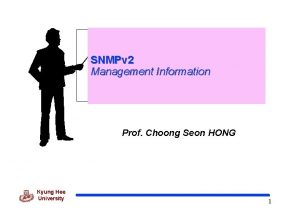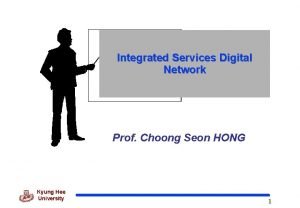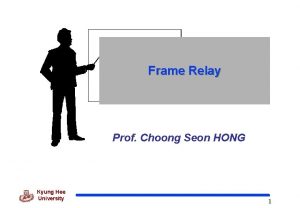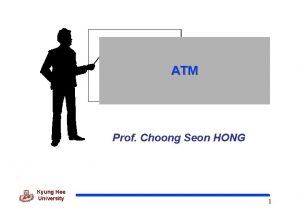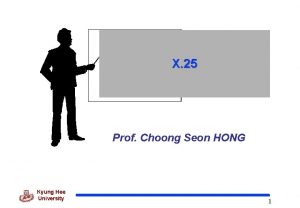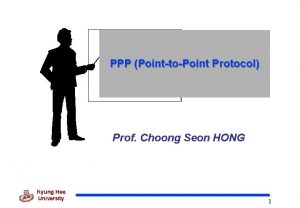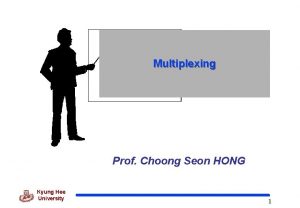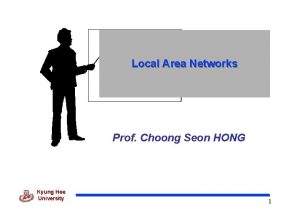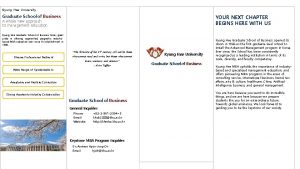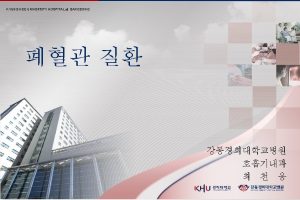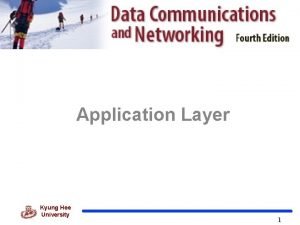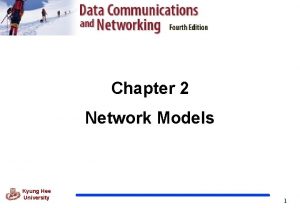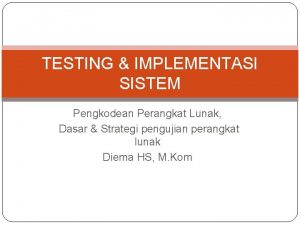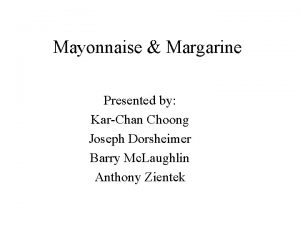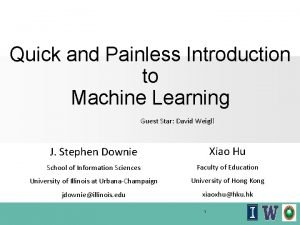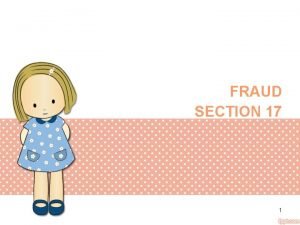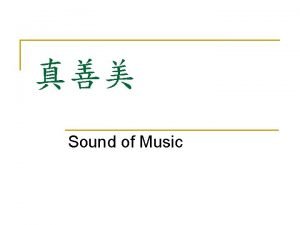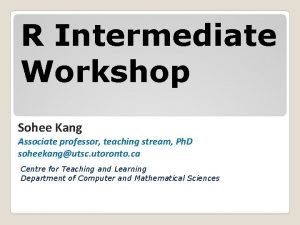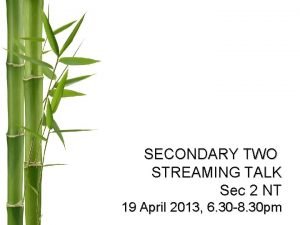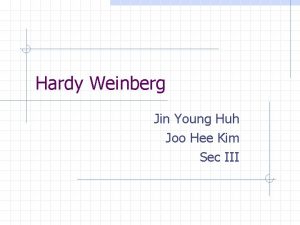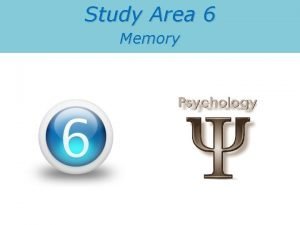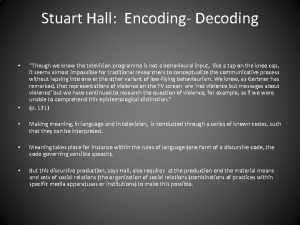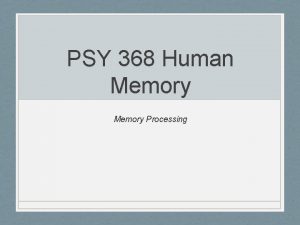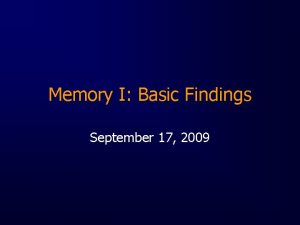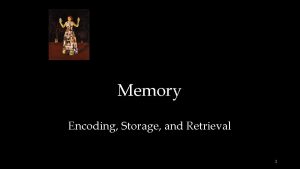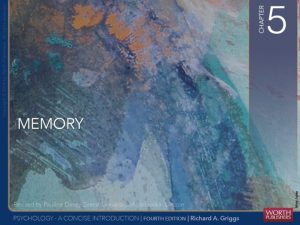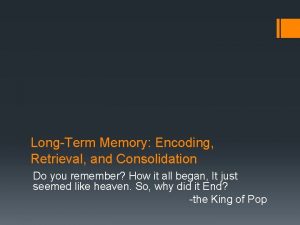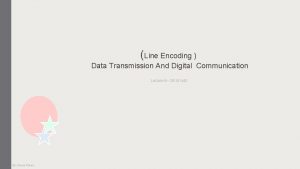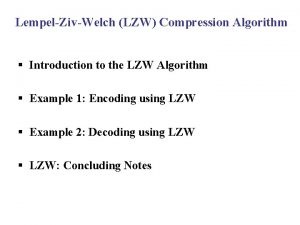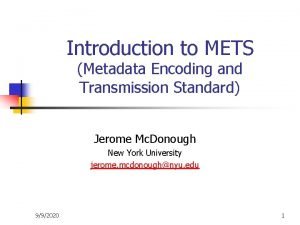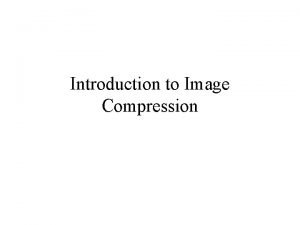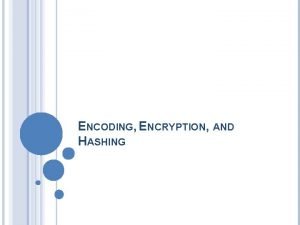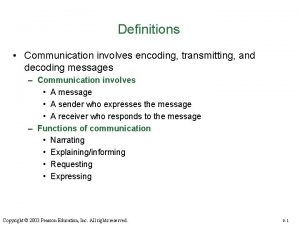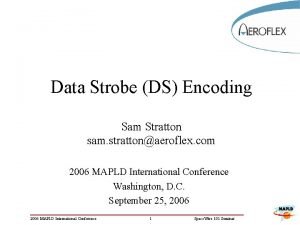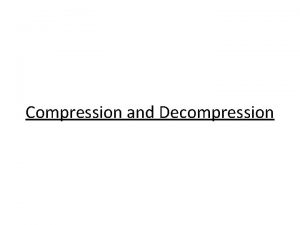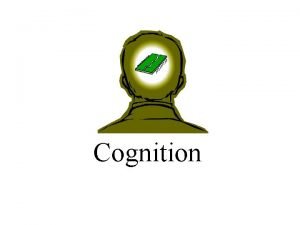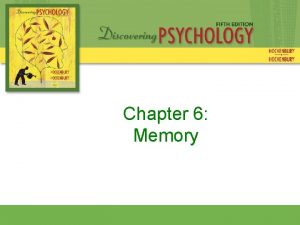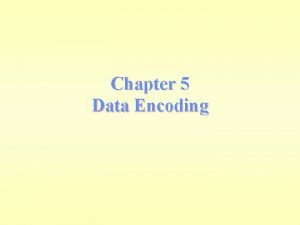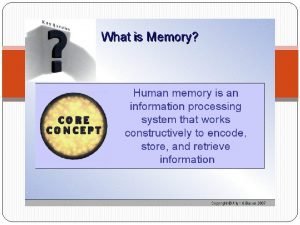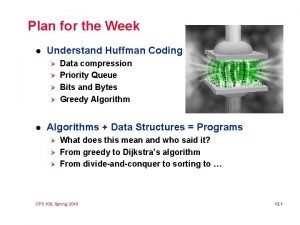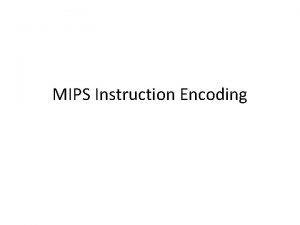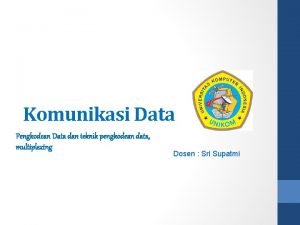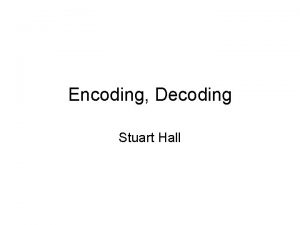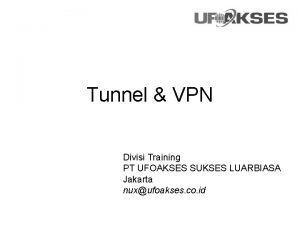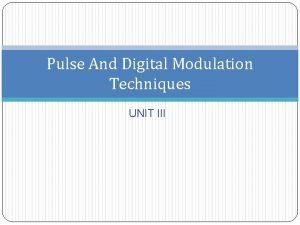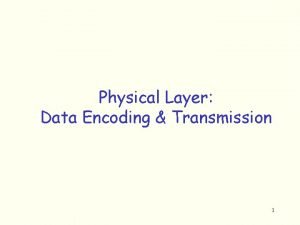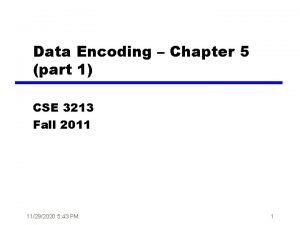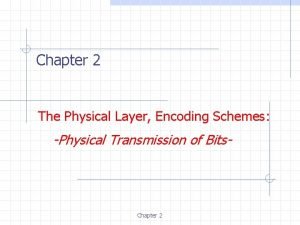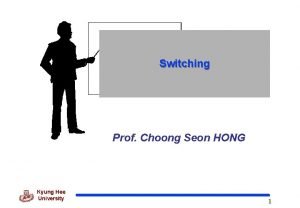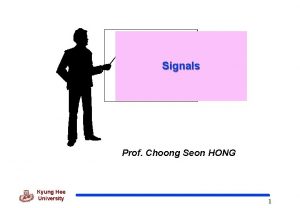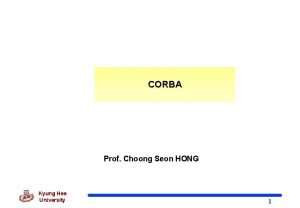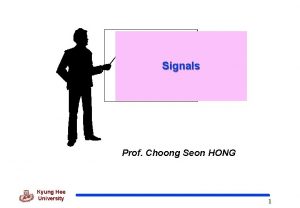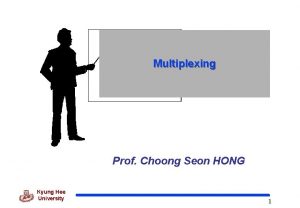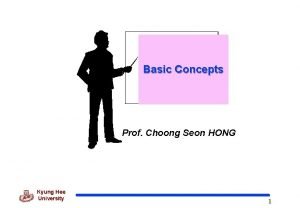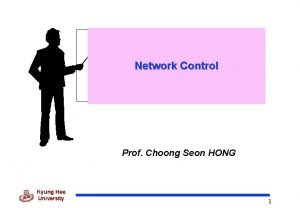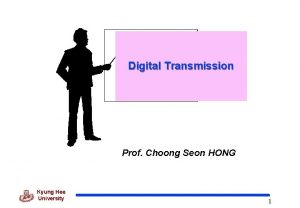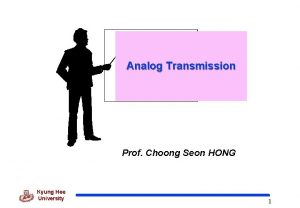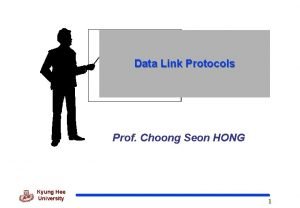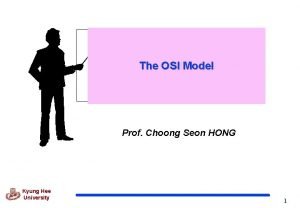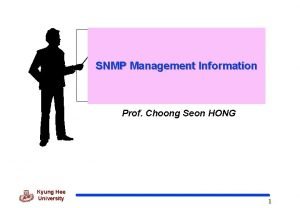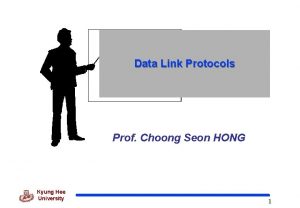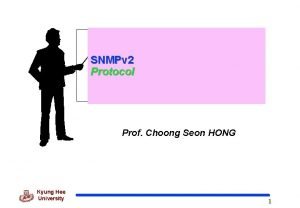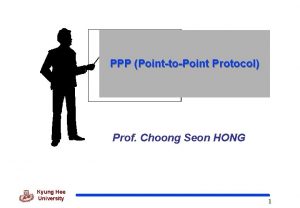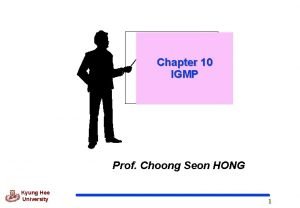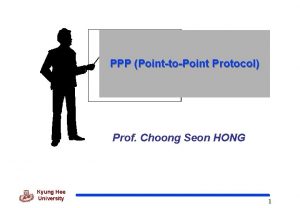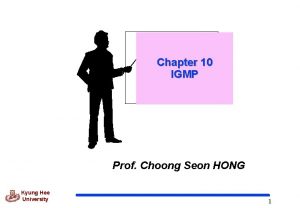Encoding Prof Choong Seon HONG Kyung Hee University








































































- Slides: 72

Encoding Prof. Choong Seon HONG Kyung Hee University 1

5 장 부호화(Encoding) 5. 1 Digital-to-Digital 5. 2 Analog-to-Digital 5. 3 Digital-to-Analog 5. 4 Analog-to-Analog Kyung Hee University 2

부호화(cont’d) q Information must be encoded into signals before it can be transported across communication media. q Different encoding schemes Kyung Hee University 3

5. 1 Digital-to-Digital 부호화 ~ is the representation of digital information by a digital signal. q Digital-to-Digital encoding Kyung Hee University 4

Digital-to-Digital 부호화(cont’d) q Types of digital-to-digital encoding Kyung Hee University 5

Digital-to-Digital 부호화(cont’d) q Unipolar uses only one level of value(1: positive value, 0: idle ) Simple and inexpensive q Unipolar encoding Kyung Hee University 6

Digital-to-Digital 부호화(cont’d) q Unipolar encoding problems almost obsolete today Having DC(Direct Current)Component : 직류성분 (a component with zero frequency) l cannot travel through media that cannot handle DC components , such as microwave. Synchronization(동기) l The receiver has to rely on a timer. Kyung Hee University 7

Digital-to-Digital 부호화(cont’d) q Polar ~ uses two levels (positive and negative) of amplitude. q Types of polar encoding Kyung Hee University 8

Digital-to-Digital 부호화(cont’d) q NRZ(Non-Return to Zero) NRZ-L : the level of the signal is dependent upon the state of the bit NRZ-I : the signal is inverted if a 1 is encountered Kyung Hee University 9

Digital-to-Digital 부호화(cont’d) q NRZ-L and NRZ-I encoding Kyung Hee University 10

Digital-to-Digital 부호화(cont’d) q. RZ(Return to Zero) using three values (positive, negative, zero) 1 : positive-to-zero 0 : negative-to-zero The signal changes not between bits but during each bit Kyung Hee University 11

Digital-to-Digital 부호화(cont’d) q. RZ encoding Kyung Hee University 12

Digital-to-Digital 부호화(cont’d) q. The main disadvantages of RZ encoding requiring two signal changes to encode one bit and therefore occupies more bandwidth Kyung Hee University 13

Digital-to-Digital 부호화(cont’d) q. Biphase provides probably the best existing solution to the problem of synchronization is implemented in two different ways. l Manchester : used by Ethernet LANs l Differential Manchester : used by Token Ring LANs Kyung Hee University 14

Digital-to-Digital 부호화(cont’d) q Manchester and Differential Manchester encoding Kyung Hee University 15

Digital-to-Digital 부호화(cont’d) q In Manchester encoding, the transition at the middle of the bit is used for both synchronization and bit representation q In Differential Manchester, the transition at the middle of the bit is used only for synchronization. Kyung Hee University 16

Digital-to-Digital 부호화(cont’d) q. Bipolar uses three voltage levels(positive, negative, zero) l zero level : binary 0 l positive and negative voltage : 1(alternate) Kyung Hee University 17

Digital-to-Digital 부호화(cont’d) q. Type of bipolar encoding Kyung Hee University 18

Digital-to-Digital 부호화(cont’d) q. Bipolar AMI(Alternate Mark Inversion) ~ is the simplest type of bipolar encoding Bipolar AMI changes poles with every 1 it encounters l These changes provide the synchronization needed by the receiver But, there is no mechanism to ensure the synchronization of a long string of 0 s Kyung Hee University 19

Digital-to-Digital 부호화(cont’d) q. Bipolar AMI encoding Kyung Hee University 20

Digital-to-Digital 부호화(cont’d) q. B 8 ZS(Bipolar 8 -Zero Substitution) is the convention adopted in North America to provide synchronization of long strings of 0 s. Kyung Hee University 21

Digital-to-Digital 부호화(cont’d) q B 8 ZS encoding Kyung Hee University 22

Digital-to-Digital 부호화(cont’d) q. HDB 3(High-Density Bipolar 3) is the convention adopted in Europe and Japan. Kyung Hee University 23

Digital-to-Digital 부호화(cont’d) q HDB 3 encoding Kyung Hee University 24

Digital-to-Digital 부호화(cont’d) q. Example 5. 1 Using B 8 ZS, encode the bit stream 100000100. Assume that the polarity of the first 1 is positive. q. Solution Kyung Hee University 25

Digital-to-Digital 부호화(cont’d) q. Example 5. 2 using HDB 3, encoded the bit stream 100000100. Assume that the number of 1 s so far is odd and the first 1 is positive. q. Solution Kyung Hee University 26

Digital-to-Digital 부호화(cont’d) q Exercise Amplitude 1 1 0 0 0 0 0 1 0 Time AMI Time B 8 ZS Time HDB 3 Kyung Hee University 27

5. 2 Analog-to-Digital 부호화 is the representation of analog information by a digital signal. (recording singer’s voice onto a compact disc) q. Analog-to-Digital Encoding Kyung Hee University 28

Analog-to-Digital 부호화(cont’d) q. PAM(Pulse Amplitude Modulation) This technique takes analog information, samples it, and generates a series of pulses based on the results of the sampling. * Term sampling means measuring the amplitude of the signal at equal intervals. Kyung Hee University 29

Analog-to-Digital 부호화(cont’d) q. PAM Kyung Hee University 30

Analog-to-Digital 부호화(cont’d) q. PCM(Pulse Code Modulation) Quantization is a method of assigning integral values in a specific range to sampled instances. Kyung Hee University 31

Analog-to-Digital 부호화(cont’d) q. Quantized PAM signal Kyung Hee University 32

Analog-to-Digital 부호화(cont’d) q. Quantized sample Assign and magnitude value (seven-bit binary equivalent) q. Quantizing using sign and magnitude Kyung Hee University 33

Analog-to-Digital 부호화(cont’d) q The binary digits are then transformed into a digital signal using one of the digital-to-digital encoding techniques(예 : unipolar) q PCM Kyung Hee University 34

Analog-to-Digital 부호화(cont’d) q. From analog signal to PCM digital code Kyung Hee University 35

Analog-to-Digital 부호화(cont’d) q. Sampling Rate How many samples are sufficient ? According to the Nyquist theorem l The sampling rate must be at least two times the highest frequency Kyung Hee University 36

Analog-to-Digital 부호화(cont’d) q Example 5. 3 What sampling rate is needed for a signal with a bandwidth of 10, 000 Hz (1000 to 11, 000 Hz) ? If the quantization is eight bits per sample, what is the bit rate ? q. Solution The sampling rate must be twice the highest frequency in the signal : l Sampling rate = 2 (11, 000) = 22, 000 samples/s Data rate = (22, 000 samples/s) (8 bits/sample) = 176 Kbps Kyung Hee University 37

Analog-to-Digital 부호화(cont’d) q Example 5. 4 A signal is sampled. Each sample requires at least 12 levels of operation (+0 to +5 and – 0 to – 5). How many bits should be sent for each sample ? q Solution need for 4 bits : one bit for the sign and three bits for the value Kyung Hee University 38

Analog-to-Digital 부호화(cont’d) q Example 5. 5 We want to digitize the human voice. What is the bit rate assuming eight bits per sample ? q Solution Human voice frequencies : 0 to 40000 Hz Sampling rate : 4000 x 2 = 8, 000 samples/second Bit Rate = sampling rate x Number of bits per sample = 8000 x 8 = 64, 000 bits/s = 64 Kbps Kyung Hee University 39

5. 3 Digital-to-Analog 부호화 q ASK(Amplitude Shift Keying) q FSK(Frequency Shift Keying) Shift Keying = modulation q PSK(Phase Shift Keying) q QAM(Quadrature Amplitude Modulation) : related to Amplitude and Phase Kyung Hee University 40

Digital-to-Analog 부호화(cont’d) q Type of Digital-to-Analog encoding Kyung Hee University 41

Digital-to-Analog 부호화(cont’d) q Bit rate : the number of bits per second. q Baud rate : the number of signal units per second. Baud rate is less than or equal to the bit rate. Bit rate equals the baud rate x the number of bits represented by each signal unit q 반송신호 또는 주파수 (Carrier Signal or Carrier Frequency) base signal for the information signal Kyung Hee University 42

Digital-to-Analog 부호화(cont’d) q Example 5. 6 An analog signal carries four bits in each signal element. If 1000 signal elements are sent per second, find the baud rate and the bit rate. q Solution Baud rate = Number of signal elements = 1000 bauds per second Bit rate = Baud rate x Number of bits per signal element = 1000 x 4 = 4000 bps Kyung Hee University 43

Digital-to-Analog 부호화(cont’d) q Example 5. 7 The bit rate of a signal : 3000 If each signal element carries six bits, what is the baud rate ? q Solution Baud rate = Bit rate/ number of bits per signal element = 3000/6 = 500 baud per second Kyung Hee University 44

Digital-to-Analog 부호화(cont’d) q. ASK(Amplitude Shift Keying) Both frequency and phase remain constant while the amplitude changes. Highly susceptible to noise interference l Noise usually affects the amplitude. Kyung Hee University 45

Digital-to-Analog 부호화(cont’d) q ASK encoding Kyung Hee University 46

Digital-to-Analog 부호화(cont’d) q Relationship between baud rate and bandwidth in ASK BW = (1 + d) x N baud Kyung Hee University N baud : Baud rate d : factor related to the condition of the line (with a minimum value of 0) 47

Digital-to-Analog 부호화(cont’d) q Example 5. 8 Find the minimum bandwidth for an ASK signal transmitting at 2000 bps. Transmission mode is half-duplex q Solution In ASK the baud rate and bit rate are the same. The baud rate is therefore 2000. An ASK signal requires a minimum bandwidth equal to its baud rate. Therefore, the minimum bandwidth is 2000 Hz Kyung Hee University 48

Digital-to-Analog 부호화(cont’d) q Example 5. 10 Given a bandwidth of 10, 000 Hz (1000 to 11, 000 Hz), draw the fullduplex ASK diagram of the system. Find the carriers and the bandwidth in each direction. Assume there is no gap between the bands in two directions. q Solution Bandwidth for each direction : 10000/2 = 5000 Hz Carrier frequencies : fc (forward) = 1000 + 5000/2 = 3500 Hz fc (backward) = 11000 – 5000/2 = 8500 Hz Kyung Hee University 49

Digital-to-Analog 부호화(cont’d) Solution to Example 5. 10 Kyung Hee University 50

Digital-to-Analog 부호화(cont’d) q. FSK(Frequency Shift Keying) the frequency of the signal is varied to represent binary 1 or 0. Kyung Hee University 51

Digital-to-Analog 부호화(cont’d) q FSK encoding Kyung Hee University 52

Digital-to-Analog 부호화(cont’d) q Bandwidth for FSK Kyung Hee University 53

Digital-to-Analog 부호화(cont’d) q. PSK(Phase Shift Keying) the phase is varied to represent binary 1 or 0. bit phase 0 180 1 0 Constellation diagram Kyung Hee University 54

Digital-to-Analog 부호화(cont’d) q PSK Kyung Hee University 55

Digital-to-Analog 부호화(cont’d) q. QAM(Quadrature Amplitude Modulation) means combining ASK and PSK in such a way that we have maximum contrast between each bit, dibit, tribit, quadbit, and so on. Kyung Hee University 56

Digital-to-Analog 부호화(cont’d) 011 q Time domain for an 8 -QAM signal 010 101 100 001 110 111 2 amplitudes, 4 phases Kyung Hee University 57

5. 4 Analog-to-Analog 부호화 q is the representation of analog information by an analog signal. q Analog-to-Analog encoding Kyung Hee University 58

Analog-to-Analog 부호화(cont’d) q Type of analog-to-analog encoding Kyung Hee University 59

Analog-to-Analog 부호화(cont’d) q. AM(Amplitude Modulation) ~ The frequency and phase of the carrier remain the same; only the amplitude changes to follow variations in the information. Kyung Hee University 60

Analog-to-Analog 부호화(cont’d) q. Amplitude modulation Kyung Hee University 61

Analog-to-Analog 부호화(cont’d) q. AM bandwidth The total bandwidth required for AM can be determined from the bandwidth of the audio signal. Kyung Hee University 62

Analog-to-Analog 부호화(cont’d) q. AM bandwidth Kyung Hee University 63

Analog-to-Analog 부호화(cont’d) q Audio signal(음성과 음악) bandwidth : 5 KHz q Minimum bandwidth : 10 KHz (bandwidth for AM radio station) q AM stations are allowed carrier frequencies anywhere between 530 and 1700 KHz(1. 7 MHz) Kyung Hee University 64

Analog-to-Analog 부호화(cont’d) q AM band allocation Kyung Hee University 65

Analog-to-Analog 부호화(cont’d) q. FM(Frequency Modulation) as the amplitude of the information signal changes, the frequency of the carrier changes proportionately. Kyung Hee University 66

Analog-to-Analog 부호화(cont’d) q. Frequency modulation Kyung Hee University 67

Analog-to-Analog 부호화(cont’d) q. FM Bandwidth The bandwidth of an FM signal is equal to 10 times the bandwidth of the modulating signal. Kyung Hee University 68

Analog-to-Analog 부호화(cont’d) q FM bandwidth Kyung Hee University 69

Analog-to-Analog 부호화(cont’d) q Bandwidth of an audio signal(음성과 음악) broadcast in stereo : 15 KHz q minimum bandwidth : 150 KHz q allows generally 200 KHz(0. 2 MHz) for each station q FM station are allowed carrier frequencies anywhere 88 and 108 MHz(each 200 KHz) Kyung Hee University 70

Analog-to-Analog 부호화(cont’d) q FM band allocation Alternate bandwidth allocation Kyung Hee University 71

Analog-to-Analog 부호화(cont’d) q. PM(Phase Modulation) ~ is used in some systems as an alternative to frequency modulation. The phase of the carrier signal is modulated to follow the changing voltage (amplitude) of the modulating signal Kyung Hee University 72
 Choong seon hong
Choong seon hong Choong seon hong
Choong seon hong Choong seon hong
Choong seon hong Choong seon hong
Choong seon hong Choong seon hong
Choong seon hong Choong seon hong
Choong seon hong Choong seon hong
Choong seon hong Choong seon hong
Choong seon hong Kyung hee university mba
Kyung hee university mba Kyung hee university hospital at gangdong
Kyung hee university hospital at gangdong Kyung hee university uniform
Kyung hee university uniform Network layer
Network layer Basic coding test
Basic coding test Captain kyung
Captain kyung Seon api
Seon api Choong joseph family
Choong joseph family Chinese university of hong kong library
Chinese university of hong kong library Hong kong baptist university school of communication
Hong kong baptist university school of communication Non jupas
Non jupas The education university of hong kong
The education university of hong kong Auslandssemester hong kong
Auslandssemester hong kong University of hong kong
University of hong kong Routing and switching
Routing and switching Out of programme pause hee
Out of programme pause hee Tan hee juan v teh boon keat
Tan hee juan v teh boon keat Horus portfolio
Horus portfolio Horus.hee
Horus.hee Fraud section 17
Fraud section 17 Choi dae hee
Choi dae hee Kim yeon hee
Kim yeon hee Hee chang trading co ltd
Hee chang trading co ltd Tan hee juan case
Tan hee juan case Hee joo lee
Hee joo lee Https://www.youtube.comwatch
Https://www.youtube.comwatch So-hee kang utsc
So-hee kang utsc Aaou
Aaou Horus eportfolio
Horus eportfolio Secondary 3 streaming
Secondary 3 streaming Joo hee jin
Joo hee jin Explicit memory
Explicit memory Stuart hall reading positions
Stuart hall reading positions Example of encoding failure
Example of encoding failure Encoding specificity
Encoding specificity Memory encoding vs consolidation
Memory encoding vs consolidation Encoding storage and retrieval
Encoding storage and retrieval Example of encoding failure
Example of encoding failure Marketing encoding
Marketing encoding Memory encoding vs consolidation
Memory encoding vs consolidation Polar encoding in data communication
Polar encoding in data communication Lzw decompression example
Lzw decompression example Mets format
Mets format Run length encoding
Run length encoding Encoding encryption and hashing
Encoding encryption and hashing Johnson encoding
Johnson encoding Encoding definition in communication
Encoding definition in communication Datastrobe
Datastrobe Run length encoding
Run length encoding Memory encoding
Memory encoding Encoding specificity
Encoding specificity Encoding data
Encoding data Example of encoding failure
Example of encoding failure Go go gophers huffman coding
Go go gophers huffman coding Mips encoding
Mips encoding Teknik pengkodean data
Teknik pengkodean data Stuart hall encoding decoding citation
Stuart hall encoding decoding citation Encoding failure ap psychology
Encoding failure ap psychology Digital data digital signals
Digital data digital signals Using encoding - mppe128 stateless
Using encoding - mppe128 stateless Pulse code modulation and demodulation
Pulse code modulation and demodulation Physical layer encoding
Physical layer encoding Digital to analog encoding
Digital to analog encoding Hdb3 encoding
Hdb3 encoding Physical layer encoding
Physical layer encoding
